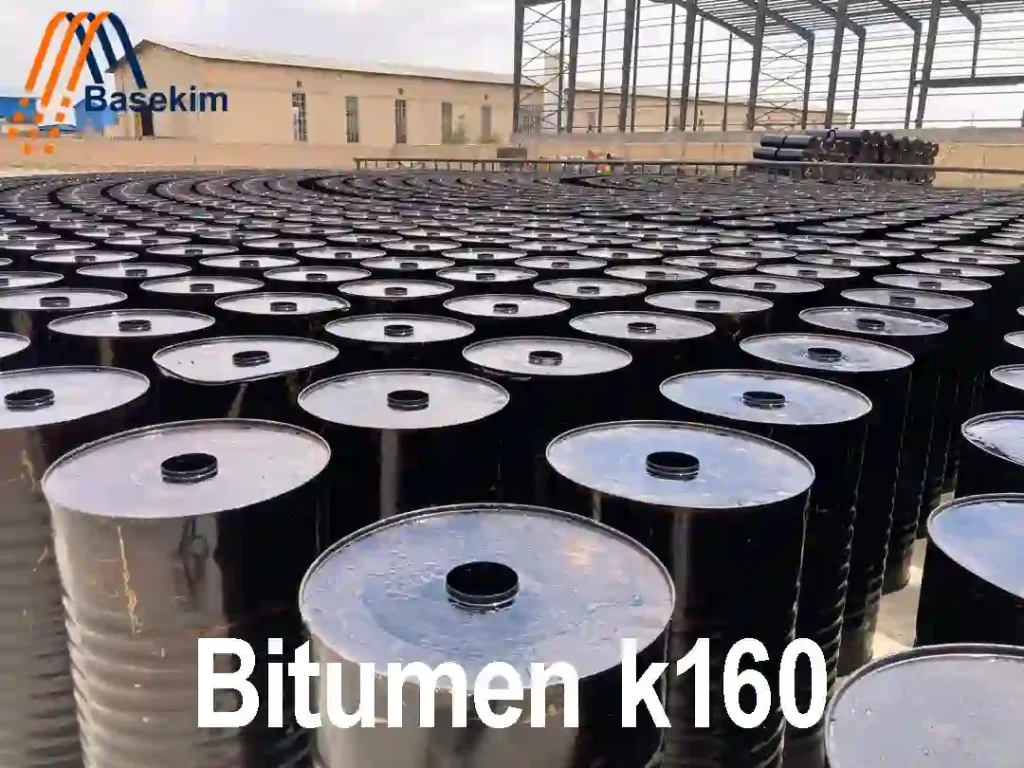- About Us
- Contact Us
- English

Bitumen K160 (K1-60) Emulsion for Tack & Prime Global Supply from UAE

Choose bitumen K160 when you want strong bonding, clean work sites, and fast-moving road crews. Because this cationic emulsion (often written K1-60) contains around 60% bitumen in water, it sprays easily at low temperature and bonds quickly to aggregates and old asphalt. As a result, pavements gain better adhesion, smoother rides, and longer life. Basekim supplies bitumen K160 from the UAE and Turkey with export-ready packaging, reliable documents, and responsive support, so your project stays on schedule.
What is bitumen K160 (K1-60) and why use it?
Simply put, bitumen K160 is a ready-to-use, water-based binder for tack coats and prime coats. Because the emulsion breaks and sets quickly, it leaves a uniform film of bitumen that helps new asphalt grip the layer below. Consequently, you reduce slippage, minimize shoving, and improve compaction. Moreover, crews can spray at ambient temperature, which means safer handling, lower fuel use, and less smoke on site. In short, you get performance without the hassle of heating cutbacks.
Where does bitumen K160 work best?
Tack coat between layers: Use bitumen K160 before placing a new asphalt lift on an existing surface; the bond becomes stronger and more reliable.
Prime coat on granular bases: Because the emulsion penetrates lightly, the surface gets a dust-free, cohesive film ready for the first asphalt layer.
Patching and pothole repairs: With quick breaking and easy spray, small teams can work faster, so traffic returns sooner.
Rural and urban roads: Since the product is water-based, neighborhoods see fewer odors and safer workflows.
Additionally, bitumen K160 suits both hot and mild climates. However, for very cold or rainy days, you should schedule application during drier windows to ensure proper breaking and adhesion.
How to apply bitumen k160 for best results
First, clean the surface; dust, mud, and loose particles weaken the bond. Next, repair potholes and seal cracks where needed. Then, spray bitumen K160 at the recommended rate using a calibrated distributor. Because uniform coverage matters, check your nozzles and maintain steady pressure. After that, allow the emulsion to break; the color will turn from brown to black. Finally, place the new asphalt while the film remains active. Therefore, density improves and layers act as one.
Practical tips
Store drums and IBCs under shade and keep lids closed; contamination changes breaking time.
Mix gently if the emulsion sits; however, avoid high-speed agitation to prevent breaking inside the tank.
Do not dilute unless your specification allows it; even then, use clean water and follow precise ratios.
Always verify the application temperature and weather; consequently, you avoid rework.
Why buy from Basekim (UAE & Turkey)?
Because Basekim focuses on road binders every day, you receive consistent quality, quick replies, and flexible logistics. We source and stock bitumen K160 in the UAE and Turkey, so lead times remain short and routing stays efficient. Moreover, we provide COA/MSDS, batch traceability, and private labeling upon request. In addition, our technical team helps match spray rates, nozzle choices, and cure windows to your site conditions. Consequently, your crews work faster with fewer surprises.
Packaging & logistics
200 kg new steel drums for wide accessibility on mixed fleets.
1,000 L IBCs for organized yards and quick mobilization.
Bulk tankers for high-volume paving jobs.
Because we load from major ports, shipping into the Middle East, Africa, Europe, and Asia stays predictable. Furthermore, we share real-time updates and clear documents to speed customs.
Compliance and quality
Basekim supplies bitumen K160 that meets common road standards for cationic emulsions similar to K1-60. Therefore, you can align tenders, audits, and site trials with confidence. Additionally, we support site sampling and third-party tests when required. As a result, your stakeholders get the proof they need.
Simple buying checklist
Confirm the job (tack or prime) and target spray rate.
Match bitumen K160 to your weather window and traffic plan.
Choose drums, IBCs, or bulk based on daily tonnage.
Align delivery dates with plant and crew schedules.
Request Basekim’s COA/MSDS and keep them on file.
Other Grades
Q1:Is bitumen K160 the same as K1-60?
Yes. Many specs write it as K1-60 to show a cationic emulsion with ~60% bitumen. People often search “bitumen K160,” and the product matches the same use cases.
Q2:Can I heat bitumen K160?
You usually do not need to heat it. Because it is water-based and low-viscosity, it sprays at ambient temperatures. However, mild warming (per spec) may help flow in cold mornings.
Q3:How fast can I open to traffic?
Typically, after the emulsion breaks and the new mat is compacted, roads can open soon. Nevertheless, always follow your engineer’s guidance and site conditions.
Contact Info
Turkey office:No.6 of Fahrettin Pasa Sokak , Galip Erdem steet, Ilkbahar Mah. Turan Gunes Ave. Çankaya Ankara
Phone:00903125147055
Dubai office: 3509 of the Burligton tower, business bay, Dubai-UAE
Phone:0097142369830